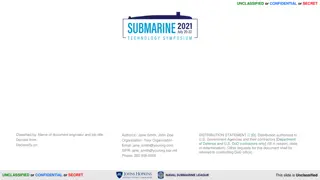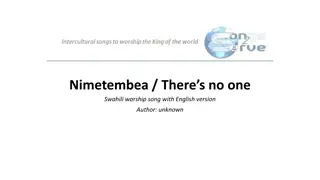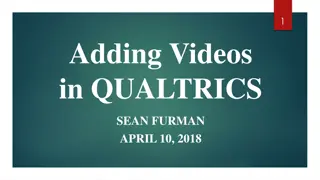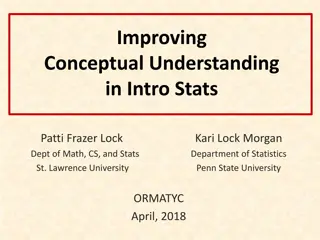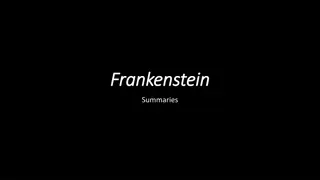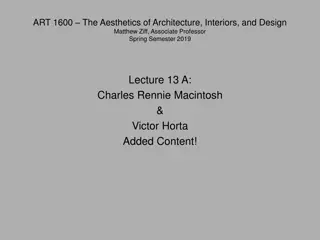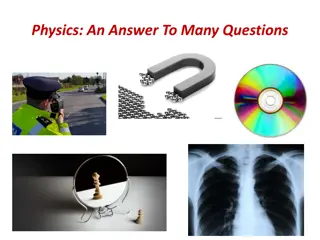Using Song Videos to Teach Introductory Physics: Innovative Approach by Dr. Victor Coronel
Explore how YouTube song videos are creatively utilized by Dr. Victor Coronel to teach introductory physics, showcasing examples like Newton's Laws through engaging visual aids. The presentation emphasizes simplicity, inclusivity, and practicality in utilizing music and videos for educational purposes.
Download Presentation

Please find below an Image/Link to download the presentation.
The content on the website is provided AS IS for your information and personal use only. It may not be sold, licensed, or shared on other websites without obtaining consent from the author.If you encounter any issues during the download, it is possible that the publisher has removed the file from their server.
You are allowed to download the files provided on this website for personal or commercial use, subject to the condition that they are used lawfully. All files are the property of their respective owners.
The content on the website is provided AS IS for your information and personal use only. It may not be sold, licensed, or shared on other websites without obtaining consent from the author.
E N D
Presentation Transcript
Using YouTube song videos to teach Introductory Physics VICTOR CORONEL, PHD ADJUNCT PROFESSOR CUNY, BARUCH COLLEGE, NY, NY
Many songs can serve to illustrate physical laws; in addition the videos that accompany them can be used as demonstration of physical phenomena or assigned problems. In this presentation I include a few of them and explain, briefly, how these videos can be used in the classroom.
General character of videos: Simplicity and clarity of concept being presented Free of gender, race, religious, biases. If possible lyrics available on video. Teacher should check veracity of video if such is implied or claimed. Some demos are camera tricks trying to pass as incredible phenomena Entertaining.
Once you find a video that helps explain a physical law or equation, make sure you download it and save a copy, as availability of videos is very fluid on the Web and on YouTube. The availability of USB s, Memory Cards, ICloud, Dropbox, etc., has made portability of the information a lot easier and very practical. There are also a large number of videos with full length lectures In physics: from Caltech you have The Mechanical Universe , From MIT you have Classical Physics ; and many school have MOOCs (Massive Online Open Courses) about physics.
Our first example is an illustration of Newtons Laws in a system known as an Atwood machine: a light pulley free to rotate around a fixed axis through its center, with a string around its top half. The ends of the string are attached To masses M1and M2. Fig 1 shows a simple version of the system, while Fig 2 shows a diagram for the forces acting on the masses. It is assumed that Frictional effects, as well as the masses of the string and pulley can be ignored. Fig 1 Fig 2
It can be shown that, if upwards is the positive vertical direction, then the acceleration of the masses M1 , a1 , and M2 , a2 , are given by a1 = [ ( M2 M1 ) / ( M1 + M2 ) ] g = - a2 The equation tells us that, when M2 > M1 , then M1 accelerates upwards while M2 accelerates downwards. when M2 = M1 a1 = 0 = a2 . If masses were at rest, they will continue at rest . when M2 < M1 , then M1 accelerates downwards while M2 accelerates upwards.
There is a song known as Dear Boss , or The sick note, or Why Paddy s not at work today , or The Bricklayer s song , and other names. It is an Irish folk song, and the version that I find as being very illustrative of the Atwood machine is the version available at this site on YouTube https://www.youtube.com/watch?v=iA5RGI3zn20 We can explain every segment of the motion with the equations developed for the accelerations, as the masses, mostly the barrel s, change values.
As a second example we choose Uniform Circular Motion, UCM: an object, mass m, in a circular trajectory, radius R moving with constant speed, v, (but the velocity v is not constant!). One can show that, for an object in UCM: The net force Fnet points towards the center and has a magnitude Fnet = m v2 / R Therefore the acceleration, a , points to the center too and its magnitude is a = v2 / R
A segment of the film The 400 Blows serves to illustrate UCM; You can find it here in YouTube. People enter a cylindrical room and position themselves against the vertical wall. The room starts Spinning around its center and, when it has a large enough speed, the floor is removed from under the spinning people, but it can be observed that they stay in a UCM on a horizontal plane. Ask students to sketch the forces acting on the boy when he is in UCM. They should be able to find that the static friction fs , matches the weigh of the boy, mg , and the net force is the normal force FN . Using fs = mg and fsmax = s FN > s m v2 / R We get that the minimum speed vmin = ( R g / s )1/2 So the variable to watch is the coefficient of static friction s .
Another example is the process of collision: objects moving towards each other, interacting and then sticking to each other or moving away from each other. The simplest case of two masses is usually presented: if masses m1 and m2 have velocities v1i and v2i right before the collision, and velocities v1f and v2fright after the collision. It can then be shown that, if all the other forces except the ones due to the interaction between the masses are considered, then m1v1i + m2 v2i = m1v1f + m2 v2f Conservation of Momentum As for the interaction force during collision (From Newton s third law they are equal and opposite) is such that the average magnitude of the force, Fave , times the time of the collision ? equals the change in the magnitude of the momentum for the mass during the collision; Fave ? = m vf m vi
If the collision time ? is very small, then, for a fixed value of the change In momentum, the average force, Fave , will be large and may cause permanent deformation of the colliding objects. When the human body has collisions it deforms; fortunately in most cases the collisions leave no significant permanent deformation, but the deformation can be observed if it is shown in slow motion as shown in this video particularly from 3 24 to 4 35 . A segment of a film with lots of collisions, some out of touch with reality, is in the Chinese film Kung Fu Hustle . The effect of a collision can be seen In the frames occurring at 0 49 and 1 11 here. this video here
Other videos you may want to consider are listed below Difficulties that not having officially adopted the metric system has caused in the USA: * Ordering food in Europe (contains profanity), from Pulp Fiction ** When a song 100 pounds of clay , is presented into the Latin American marked it had to be 100 kilos of clay changing a bit the creation. Reduction of air density with altitude in the section 0 :30 to 0 :60 of this version of Come Fly with me . The buoyant force and the case of a dead human body: why the , impractical and rarely used, practice of placing cement shoes ; You can listen and read 1 :32 to 2 :15 from Louis Armstrong , or 0 :50 to 1 :35 from Bobby Darin; both versions of Mack the Knife
In the study of vibrations and waves, it is very useful and inexpensive to download for free the software Audacity which allows us to observe the shape of sound waves when we talk, whistle (sinusoidal), and tap our upper palate with our tongue (damped oscillator) In this song , El que sabe sabe , you can hear how the tapping is used as a musical instrument 2 :27 to 2 :35 and how the whistling can be used as a flute 2 :36 to 2 :48. On YouTube one can find a very large demos on vibrations and waves, but, in my personal experience, it is best to do the actual demo in class as any demo in class is a lot better than any video. In some cases the video is convenient and cannot be replaced by a class Demo. A point in case is the phenomena of resonance.
The collapse of the Tacoma Narrows bridge is a well documented effect of resonance that certainly cannot be repeated in class!!; there are many versions but one of my favorites is this one . Another example that could be dangerous to repeat in class, is the breaking of a glass with the voice. In this video you can point out why the children are so lucky no accidents occurred.






